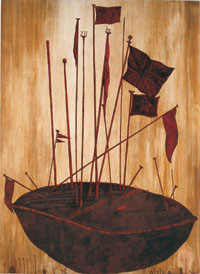

  |
||
 Needlework, 1993 Oil on linen 183 x 152 cm Private Collection |

Born 1964, Upper Hutt, New Zealand; lives in Palmerston
North, New Zealand
“My work is very much related to a personal journey of awareness. While in some ways my paintings are attempting to negotiate things for the future, what really interests me at the moment is things of the past.” Shane Cotton belongs to the Maori tribes (iwis) Ngati Rangi, Nga Puhi, and Ngati Hine. His five paintings in the exhibition bring together iconography that is of both Maori and European origin to recount the transformation of Maori culture following British settlement of New Zealand. Needlework (1993) features a series of flags, including the Union Jack and those bearing a cross, crescent, and six-pointed star, a reference to the Maori resistance leader Te Kooti Arikirangi Te Turuki, one of the most effective guerilla fighters in New Zealand’s history. Some of the flagpoles are not altogether upright, which suggests that the British claim to New Zealand, originally announced with the staking of a flag, is not altogether certain. The flags are stuck into a landmass that looks like both a small island and a pincushion. Cotton’s imagery has been influenced by his discovery that since first contact the Maori had incorporated references to the British in their artwork. His appropriation of various iconographies, sometimes overlaid upon one another, creates dense images about how history, language, and cultural domination intertwine. Cotton’s references include square-style representations of ancestors (tikis), painted scroll designs (kowhaiwhai) that are usually on the rafters of Maori meeting houses, Christian crosses, and local flora. Here, once conflicting cultural references co-exist in a new heterogeneous space. Asia Society chat with the artist: Exile does figure in my work, the idea of a journey, for instance. My work reflects where we are going from the starting point to the end point, and the question of what we are going to be when we get to where we are going. I am interested in that journey, in the way that one’s identity is shaped, and how the journey becomes something malleable, the series of changes and evolutions that occur. I am interested in the argument for tradition, traditional iconography and what that actually means to us in the present-day, how it is relevant, or rather how we make it important. It is really about the maintenance of tradition and the way that can sometimes become eroded due to outside influences and things that intimate change. It is also about knowing that New Zealand is a country which has been built by the indigenous people there, the Maori, and the kinds of changes that have developed bi-culturally and how we are searching for this utopian ideal that we can somehow become one people, which is a very romantic vision. We are two groups of people who are now becoming several groups of people bumping into one another, which is defining the culture, or really the multiculturalism. This is what is unique to New Zealand and I expect this might be the case in other Pacific Island places as well. There is this continual to-and-fro and negotiation between peoples in terms of collapsing our beliefs and identities. |